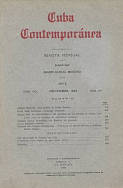4.4.9 The magazine “Cuba Contemporánea”, founded in 1913 and ceased in 1927

The magazine “Cuba Contemporénea,” published monthly, published its first issue on January 19, 1913, inheriting the “Revista de Cuba” and “Revista Cubana,” by José Manuel Cortina and Enrique José Varona, respectively. It was edited by Carlos de Velasco until 1920, when he died and was replaced by Mario Guiral Moreno, who remained its editor until its dissolution in 1927.
According to Marcelo Pogolotti, who apparently quotes an issue of the magazine, it aimed to: “revive the energies of its fellow citizens, lulled by the lusts of some and the bad faith of others.”
Politically, it was liberal in its orientation, and its pages already reveal a certain anti-imperialism, championed by Varona, who served as a kind of spiritual guide. The concerns expressed ranged in nature, including the immigration of bracero workers and what this meant for workers, divorce, and other issues related to women and the separation of state and church.
From an educational perspective, although not all the authors of the articles agreed on the same criteria, the prevailing idea was that education should be secular, in line with the postulates of Martí. An article by Julio Villoldo addresses the dangers of sending children to study abroad—a centuries-old custom of the wealthy class—as it leads to the loss of identity values during the development of personality.
The figure of Martí has merited some, but still very superficial, approaches, mostly due to Nestor Carbonell, but nonetheless important for being preliminary approximations, testimonies of a laudatory vocation not yet fully aware of its own reasons.
Regarding the expression of the discoveries of the various literary genres, much of the work of our first essayists was collected in its pages, as were the first realizations of the transformative work that Regino Eladio Boti and José Manuel Poveda would undertake on the national lyrical substance. However, fiction did not have prominent representatives in the magazine, perhaps due to its own limited development, with the exception of Carlos Loveira and Miguel de Carrión.
The magazine had numerous contributors, including: Max Henríquez Ureña, Dulce María Borrero, Alfonso Hernández Catá, José Antonio Ramos, José María Chacón y Calvo, Carlos Loveira, Emilio Roig, Jesús Castellanos, Enrique José Varona, Fernando Ortiz, Regino Eladio Boti, José Manuel Poveda, Miguel de Carrión, Juan Marinello, Jorge Mañach and others.








